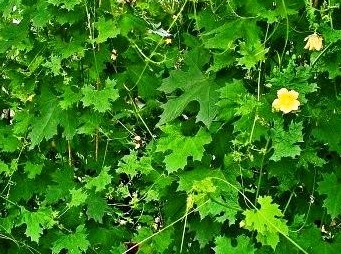Momordica balsamina

|
|
Momordica balsamina Common Names: Balsam apple, African cucumber, Southern
balsam pear, African pumpkin Scientific
Classification Kingdom: Plantae Clade: Tracheophytes Clade: Angiosperms Clade: Eudicots Clade: Rosids Order: Cucurbitales Family: Cucurbitaceae Genus: Momordica Species: M. balsamina Synonyms: None
widely documented Morphological Description Momordica balsamina is a monoecious, climbing or trailing herb, typically
extending up to 5 meters, with a tuberous rootstock. Its key characteristics
include: · Stems: Thin, angular, slightly pubescent, green, with tendrils for
climbing (Bharathi & John, 2013). · Leaves: Alternate, heart-shaped to broadly ovate (5–12 cm × 5–10
cm), deeply 3–7-lobed, with serrated margins, pubescent, dark green (Thakur et
al., 2009). · Flowers: Solitary, pale yellow to cream, trumpet-shaped (2–4 cm
diameter), unisexual; male flowers with 5 petals, female flowers with inferior
ovary; flowering during rainy season (July–October) (Kew Science, n.d.). · Fruit: Ovoid-ellipsoid berries (2.5–4.5 cm), warty, green when
immature, turning bright orange to red when ripe; split open to reveal 10–20
seeds in scarlet, sticky arils (Bharathi & John, 2013). Distribution and Habitat Momordica balsamina is native to tropical Africa and the southwestern Arabian Peninsula,
with widespread naturalization: · Geographic Range: Native to Africa (South Africa, Nigeria,
Senegal, Ethiopia) and Yemen; naturalized in Australia, India, Southeast Asia,
Central America, and North America (Florida, Texas); in Nigeria, common in northern
savanna (e.g., Kano, Bauchi) and southern regions (e.g., Cross River) (Kew
Science, n.d.; Thiaw et al., 2023). · Habitat: Thrives in lowland and montane rainforests, forest edges,
savanna woodlands, and disturbed areas (roadsides, farmlands); prefers well-drained,
loamy soils (pH 5.0–6.5) with 800–2,000 mm annual rainfall; occurs at
elevations up to 1,500 m (Bharathi & John, 2013; Fern, 2024). · Ecological Role: Pioneer species in disturbed areas;
attracts pollinators (bees); fruits consumed by birds, aiding seed dispersal;
can be invasive, forming dense stands (Thakur et al., 2009). Ethnopharmacology Momordica balsamina, known as balsam apple, is a cornerstone of traditional medicine
in Nigeria, South Africa, and other African regions, valued for its antimicrobial,
antimalarial, and antidiabetic properties. Its pharmacological potential is
driven by a diverse phytochemical profile, with robust studies validating
traditional uses. Traditional Uses In African
ethnomedicine, particularly among Hausa, Yoruba, and Zulu communities, Momordica balsamina is used for: · Infections: Leaf and fruit pastes treat wounds, boils, and skin
infections; decoctions manage dysentery and diarrhea (Odugbemi, 2008). · Malaria and Fever: Leaf and root infusions are used as antimalarial
and febrifuge remedies (Neuwinger, 2000). · Diabetes: Root and leaf extracts reduce blood sugar, particularly
among Bapedi healers in South Africa (Ramalhete et al., 2022). · Inflammation and Pain: Leaf decoctions relieve arthritis, muscle
pain, and headaches (Burkill, 1985). · HIV/AIDS: Leaf extracts are used by Senegalese healers to manage HIV
symptoms. · Gastrointestinal Issues: Fruit and leaf extracts treat ulcers,
diarrhea, and intestinal worms (Thakur et al., 2009). · Fertility Regulation: Seeds and fruits are used as
contraceptives in some African cultures (Neuwinger, 2000). Pharmacological Studies Pharmacological studies
have validated several traditional uses of Momordica balsamina, focusing on its leaves, fruits, and roots: · Antimicrobial Activity: Methanolic leaf extracts inhibited
*Staphylococcus aureus* (MIC: 0.5 mg/mL), *Escherichia coli* (MIC: 1 mg/mL),
and *Candida albicans* (MIC: 2 mg/mL), with flavonoids and saponins disrupting
microbial membranes, supporting use for infections (Aliyu et al., 2011). · Antimalarial Activity: Ethanolic fruit extracts showed
antiplasmodial activity against *Plasmodium falciparum* (IC50: 5 µg/mL) in
vitro and reduced parasitemia in *Plasmodium berghei*-infected mice by 60% at
500 mg/kg, with cucurbitacins as key compounds, validating traditional
antimalarial use (Benoit-Vical et al., 2006). · Antidiabetic Activity: it has ant diabetic activity · Anticancer Activity: Cucurbitacins from leaves inhibited
multidrug-resistant cancer cell lines ⚠ Safety
Considerations: Momordica balsamina is
generally safe at therapeutic doses when properly prepared, but some risks are
noted: Seed and Rind Toxicity: Raw seeds and fruit rind may cause
gastrointestinal distress (nausea, vomiting) due to cucurbitacins; Tsonga
communities cook fruits to reduce toxicity (Thakur et al., 2009). High Doses:
Acute toxicity studies showed no mortality in rats at methanolic leaf extract
doses up to 5,000 mg/kg (LD50 > 5,000 mg/kg), but sub-chronic doses
(>1,000 mg/kg) caused mild liver enzyme elevation (ALT increased by 10%)
(Akinlabi et al., 2016). Allergic Reactions: Prolonged exposure to leaf sap may
cause dermatitis in sensitive individuals (Neuwinger, 2000). Additional Information · Nutritional Value: Leaves contain 22% crude protein, 17 amino
acids, and minerals (potassium, magnesium, iron); fruits are rich in vitamins A
and C. · Practical Uses: Saponin-rich fruits and leaves serve as
soap substitutes; sap is used as a metal cleaner and arrow poison in some
African cultures (Burkill, 1985). · Ecological Role: Enhances biodiversity in disturbed
ecosystems; supports pollinators; can be invasive, forming dense stands that
displace native flora (Thiaw et al., 2023). · Cultural Significance: Used in Hausa and Zulu rituals for
spiritual cleansing; revered as a “gifted plant” for its medicinal potency
(Odugbemi, 2008). References
External Links More Pictures |
|
| Compounds of Momordica balsamina | |
| References |